- Joined
- Feb 2, 2011
- Messages
- 2,093
NEW RELEASES FOR SEPTEMBER 2023
THUNDER ON THE PLAINS
THE BLACK HILL WARS 1876-1877
THE BATTLE WHERE THE GIRL SAVED HER BROTHER, 17[SUP]th[/SUP] JUNE 1876
The Cheyenne named, the more commonly known The Battle Of The Rosebud, The Battle Where The Girl Saved Her Brother. This was because of an incident during the fight involving the Cheyenne woman Buffalo Calf Road Woman, and her brother Chief Comes In Sight.
The battle took place on June 17[SUP]th[/SUP] 1876 in the Montana territory , between the United States Army and its Crow and Shoshoni allies, against a force consisting mostly of Sioux and Cheyenne Indians.
Led by Crazy Horse, the Sioux and Cheyenne managed to halt the offensive of General George Crook, untill August.

Warrior Societies were an important aspect of the Plains life, which divided a tribe’s fighting men into distinct units which provided their members with a social club, and an organization in which they could progress through ranks of officership to bring great prestige.
Among the Lakota there existed several Warrior societies. The main function of these societies was for the training and development of fighting skills and the warrior ethos.
Moral character was also cultivated and taught.
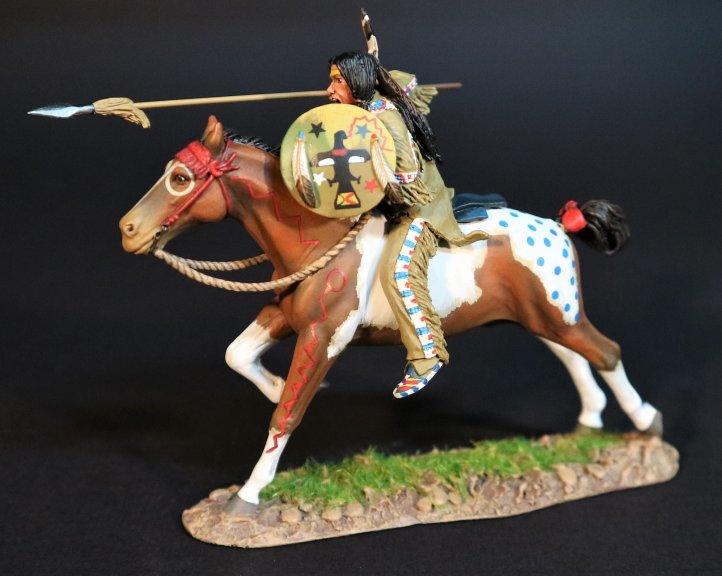
SSB-11
THUNDER ON THE PLAINS
THE BLACK HILL WARS 1876-1877
THE BATTLE WHERE THE GIRL SAVED HER BROTHER, 17[SUP]th[/SUP] JUNE 1876,
SIOUX WARRIOR
Under the leadership of Crazy Horse, the Cheyenne and Lakota Sioux had been skirmishing with the United States forces. Many warriors had charged, and one man who had the best horse was in the lead. This was Chief Comes In Sight. Before he could reach the soldiers, his horse was wounded and its hind leg broken. The Cheyenne retreated leaving Chief Comes In Sight on foot in the battlefield. SAs he was walking away with all the soldiers shooting at him, Buffalo Calf Road Woman rode out onto the battlefield at full speed and grabbed up her brother, carrying him to safety. Her courageous rescue caused the Cheyenne to rally, and they defeated General George Crook and his forces.
In honour of this brave deed, the Cheyenne named the battle, “The Battle Where The Girl Saved Her Brother.”
The battle which ensued would last for six hours and consisted of disconnected actions and charges and counter-charges by Crook and Crazy Horse, the two forces spread out over a fluid front three miles wide. The Lakota Sioux and Cheyenne were divided into several groups as were the soldiers as the battle progressed. The soldiers could fend off assaults by the Indians and force them to retreat but could not catch and destroy them
The soldiers were impressed with the swarming Indians. "They were the best cavalry soldiers on earth. In charging up toward us they exposed little of their person, hanging on with one arm around the neck and one leg over the horse, firing and lancing from underneath the horses' necks, so that there was no part of the Indian at which we could aim."
THUNDER ON THE PLAINS
THE BLACK HILL WARS 1876-1877
THE BATTLE OF THE ROSEBUD, 17[SUP]th[/SUP] JUNE 1876
UNITED STATES INFANTRY
Although the Native Americans hated the US cavalry during the Indian Wars of 1865 through 1891, they learned to respect the infantry.
Crazy Horse called them “Walk-a-Heaps” because they marched into battle.
Duty for the US Army on the frontier consisted mainly of patrolling and small unit actions. For the infantryman this typically involved long, forced marches and counter-marches as they sought contact, which was usually unsuccessful, as the Native Americans were a skilful and elusive foe.
The first day’s march for an infantry column was usually limited to no more than 15 miles in order to give the troops an opportunity to adapt themselves to the conditions. For Campaign seasoned troops, 25 miles was considered a good day’s march.
Cavalry could travel faster and further, but their grain fed mounts tended to tire after days of continual marching and surprisingly, well trained infantry could outdistance cavalry units over a period of several weeks.

On 28[SUP]th[/SUP] May 1876, Brigadier General George Crook assumed direct command of the Bighorn and Yellowstone Expedition at Fort Fetterman. Crook had gathered a strong force. Leaving Fort Fetterman on 29[SUP]th[/SUP] May the 1,051man column consisted of 15 companies from the 2[SUP]nd[/SUP] and 3[SUP]rd[/SUP] Cavalry, 5 companies from the 4[SUP]th[/SUP] and 9[SUP]th[/SUP] Infantry, 250 mules and 106 wagons.
On the 14[SUP]th[/SUP] June, the column was joined by 261 Shoshone and Crow allies.
Based on intelligence reports Crook ordered his entire force to prepare for a quick march. Each man was to carry only 1 blanket, 100 rounds of ammunition, and 4 days rations. The wagon train would be left at Goose Creek, and the infantry would be mounted on the pack mules.
On 17 June, Crook's column set out at 0600, marching northward along the south fork of Rosebud Creek. The Crow and Shoshone scouts were particularly apprehensive. Although the column had not yet encountered any sign of Indians, the scouts seemed to sense their presence. The soldiers, particularly the mule-riding infantry, seemed fatigued from the early start and the previous day's 35-mile (56 km) march. Accordingly, Crook stopped to rest his men and animals at 0800. Although he was deep in hostile territory, Crook made no special dispositions for defense. His troops halted in their marching order. The Cavalry battalions led the column, followed by the battalion of mule-borne foot soldiers, and a provisional company of civilian miners and packers brought up the rear.
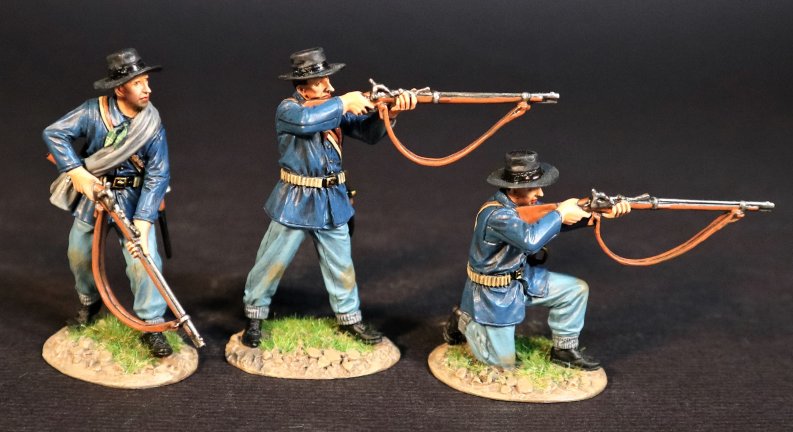
RSBUD-141516D
THUNDER ON THE PLAINS
THE BLACK HILL WARS 1876-1877
THE BATTLE OF THE ROSEBUD, 17[SUP]th[/SUP] JUNE 1876,
UNITED STATES MOUNTED INFANTRY
The Crow and Shoshone scouts remained alert while the soldiers rested. Several minutes later, the soldiers heard the sound of intermittent gunfire coming from the bluffs to the north. As the intensity of fire increased, a scout rushed into the camp shouting, "Lakota, Lakota!" The Battle of the Rosebud had started. By 0830, the Sioux and Cheyenne had hotly engaged Crook's Indian allies on the high ground north of the main body. Heavily outnumbered, the Crow and Shoshone scouts fell back toward the camp, but their fighting withdrawal gave Crook time to deploy his forces. Rapidly firing soldiers drove off the attackers but used up much of the ammunition meant for use later in the campaign. Low on ammunition and with numerous wounded, the General returned to his post.
Historians debate whether Crook’s pressing on could have prevented the killing of the five companies of the 7[SUP]th[/SUP] Cavalry Regiment led by George Armstrong Custer at the Battle of the Little Bighorn.
The Sioux troubles increased the need for mounted troops on the frontier, and as early as December 6[SUP]th[/SUP] 1866, elements of the 18[SUP]th[/SUP] Infantry were mounted, and operating alongside Cavalry.
The practice of using mounted infantry continued until the end of the Indian wars.
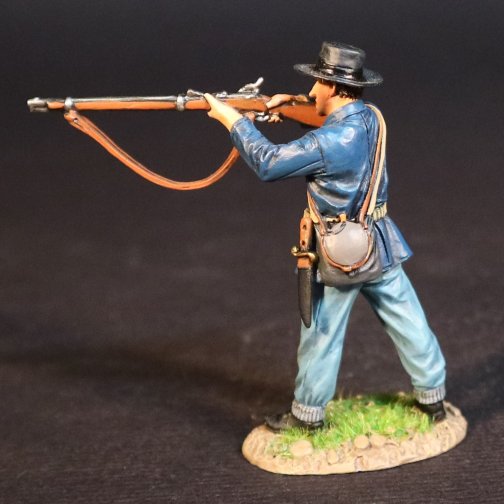
RSBUD-14
THE BATTLE OF THE ROSEBUD, 17[SUP]th[/SUP] JUNE 1876,
UNITED STATES MOUNTED INFANTRY
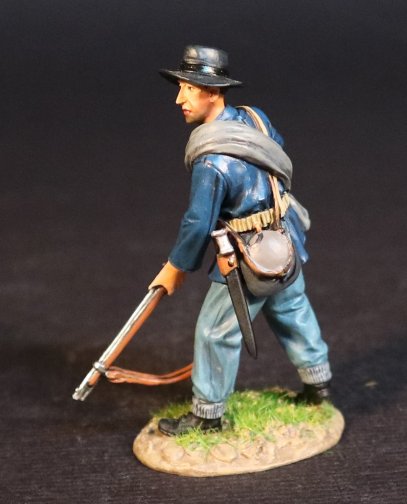
RSBUD-15
THE BATTLE OF THE ROSEBUD, 17[SUP]th[/SUP] JUNE 1876,
UNITED STATES MOUNTED INFANTRY
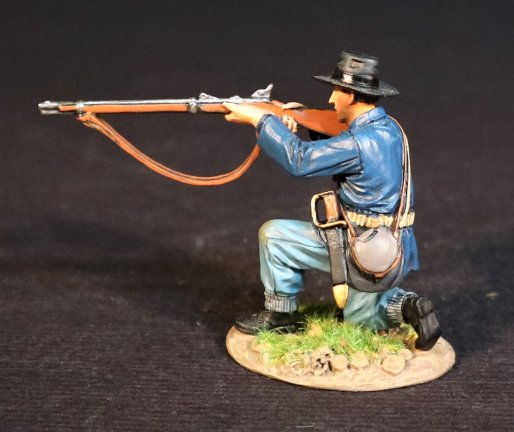
RSBUD-16
THE BATTLE OF THE ROSEBUD, 17[SUP]th[/SUP] JUNE 1876,
UNITED STATES MOUNTED INFANTRY
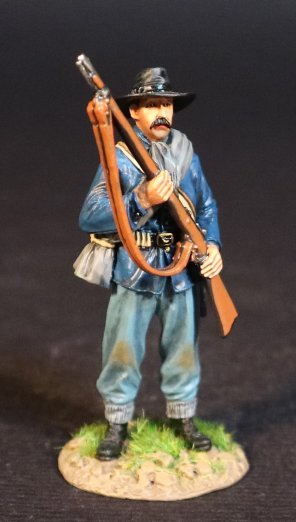
RSBUD-17
THE BATTLE OF THE ROSEBUD, 17[SUP]th[/SUP] JUNE 1876,
UNITED STATES MOUNTED INFANTRY
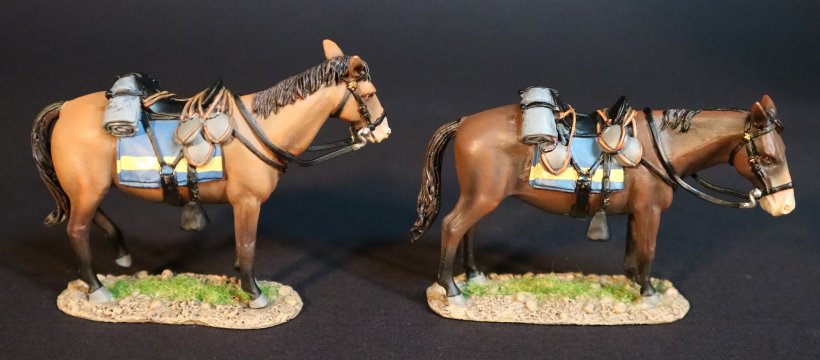
HRSBUD-03A
THUNDER ON THE PLAINS
THE BLACK HILL WARS 1876-1877
THE BATTLE OF THE ROSEBUD, 17[SUP]th[/SUP] JUNE 1876,
ARMY MULES
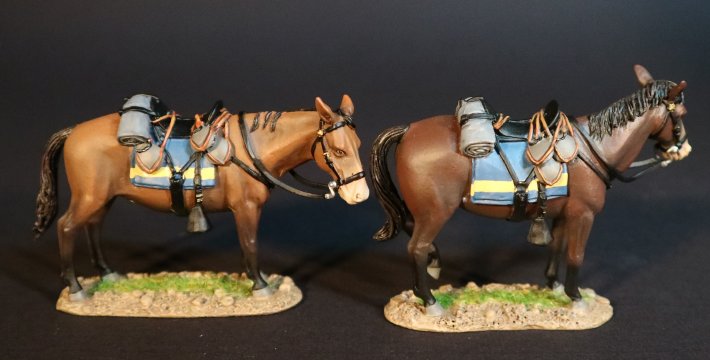
HRSBUD-03B
THUNDER ON THE PLAINS
THE BLACK HILL WARS 1876-1877
THE BATTLE OF THE ROSEBUD, 17[SUP]th[/SUP] JUNE 1876,
ARMY MULES
** PLEASE CONTACT YOUR LOCAL DEALER FOR FURTHER INFORMATION **
THUNDER ON THE PLAINS
THE BLACK HILL WARS 1876-1877
THE BATTLE WHERE THE GIRL SAVED HER BROTHER, 17[SUP]th[/SUP] JUNE 1876
The Cheyenne named, the more commonly known The Battle Of The Rosebud, The Battle Where The Girl Saved Her Brother. This was because of an incident during the fight involving the Cheyenne woman Buffalo Calf Road Woman, and her brother Chief Comes In Sight.
The battle took place on June 17[SUP]th[/SUP] 1876 in the Montana territory , between the United States Army and its Crow and Shoshoni allies, against a force consisting mostly of Sioux and Cheyenne Indians.
Led by Crazy Horse, the Sioux and Cheyenne managed to halt the offensive of General George Crook, untill August.

Warrior Societies were an important aspect of the Plains life, which divided a tribe’s fighting men into distinct units which provided their members with a social club, and an organization in which they could progress through ranks of officership to bring great prestige.
Among the Lakota there existed several Warrior societies. The main function of these societies was for the training and development of fighting skills and the warrior ethos.
Moral character was also cultivated and taught.

SSB-11
THUNDER ON THE PLAINS
THE BLACK HILL WARS 1876-1877
THE BATTLE WHERE THE GIRL SAVED HER BROTHER, 17[SUP]th[/SUP] JUNE 1876,
SIOUX WARRIOR
Under the leadership of Crazy Horse, the Cheyenne and Lakota Sioux had been skirmishing with the United States forces. Many warriors had charged, and one man who had the best horse was in the lead. This was Chief Comes In Sight. Before he could reach the soldiers, his horse was wounded and its hind leg broken. The Cheyenne retreated leaving Chief Comes In Sight on foot in the battlefield. SAs he was walking away with all the soldiers shooting at him, Buffalo Calf Road Woman rode out onto the battlefield at full speed and grabbed up her brother, carrying him to safety. Her courageous rescue caused the Cheyenne to rally, and they defeated General George Crook and his forces.
In honour of this brave deed, the Cheyenne named the battle, “The Battle Where The Girl Saved Her Brother.”
The battle which ensued would last for six hours and consisted of disconnected actions and charges and counter-charges by Crook and Crazy Horse, the two forces spread out over a fluid front three miles wide. The Lakota Sioux and Cheyenne were divided into several groups as were the soldiers as the battle progressed. The soldiers could fend off assaults by the Indians and force them to retreat but could not catch and destroy them
The soldiers were impressed with the swarming Indians. "They were the best cavalry soldiers on earth. In charging up toward us they exposed little of their person, hanging on with one arm around the neck and one leg over the horse, firing and lancing from underneath the horses' necks, so that there was no part of the Indian at which we could aim."
THUNDER ON THE PLAINS
THE BLACK HILL WARS 1876-1877
THE BATTLE OF THE ROSEBUD, 17[SUP]th[/SUP] JUNE 1876
UNITED STATES INFANTRY
Although the Native Americans hated the US cavalry during the Indian Wars of 1865 through 1891, they learned to respect the infantry.
Crazy Horse called them “Walk-a-Heaps” because they marched into battle.
Duty for the US Army on the frontier consisted mainly of patrolling and small unit actions. For the infantryman this typically involved long, forced marches and counter-marches as they sought contact, which was usually unsuccessful, as the Native Americans were a skilful and elusive foe.
The first day’s march for an infantry column was usually limited to no more than 15 miles in order to give the troops an opportunity to adapt themselves to the conditions. For Campaign seasoned troops, 25 miles was considered a good day’s march.
Cavalry could travel faster and further, but their grain fed mounts tended to tire after days of continual marching and surprisingly, well trained infantry could outdistance cavalry units over a period of several weeks.

On 28[SUP]th[/SUP] May 1876, Brigadier General George Crook assumed direct command of the Bighorn and Yellowstone Expedition at Fort Fetterman. Crook had gathered a strong force. Leaving Fort Fetterman on 29[SUP]th[/SUP] May the 1,051man column consisted of 15 companies from the 2[SUP]nd[/SUP] and 3[SUP]rd[/SUP] Cavalry, 5 companies from the 4[SUP]th[/SUP] and 9[SUP]th[/SUP] Infantry, 250 mules and 106 wagons.
On the 14[SUP]th[/SUP] June, the column was joined by 261 Shoshone and Crow allies.
Based on intelligence reports Crook ordered his entire force to prepare for a quick march. Each man was to carry only 1 blanket, 100 rounds of ammunition, and 4 days rations. The wagon train would be left at Goose Creek, and the infantry would be mounted on the pack mules.
On 17 June, Crook's column set out at 0600, marching northward along the south fork of Rosebud Creek. The Crow and Shoshone scouts were particularly apprehensive. Although the column had not yet encountered any sign of Indians, the scouts seemed to sense their presence. The soldiers, particularly the mule-riding infantry, seemed fatigued from the early start and the previous day's 35-mile (56 km) march. Accordingly, Crook stopped to rest his men and animals at 0800. Although he was deep in hostile territory, Crook made no special dispositions for defense. His troops halted in their marching order. The Cavalry battalions led the column, followed by the battalion of mule-borne foot soldiers, and a provisional company of civilian miners and packers brought up the rear.

RSBUD-141516D
THUNDER ON THE PLAINS
THE BLACK HILL WARS 1876-1877
THE BATTLE OF THE ROSEBUD, 17[SUP]th[/SUP] JUNE 1876,
UNITED STATES MOUNTED INFANTRY
The Crow and Shoshone scouts remained alert while the soldiers rested. Several minutes later, the soldiers heard the sound of intermittent gunfire coming from the bluffs to the north. As the intensity of fire increased, a scout rushed into the camp shouting, "Lakota, Lakota!" The Battle of the Rosebud had started. By 0830, the Sioux and Cheyenne had hotly engaged Crook's Indian allies on the high ground north of the main body. Heavily outnumbered, the Crow and Shoshone scouts fell back toward the camp, but their fighting withdrawal gave Crook time to deploy his forces. Rapidly firing soldiers drove off the attackers but used up much of the ammunition meant for use later in the campaign. Low on ammunition and with numerous wounded, the General returned to his post.
Historians debate whether Crook’s pressing on could have prevented the killing of the five companies of the 7[SUP]th[/SUP] Cavalry Regiment led by George Armstrong Custer at the Battle of the Little Bighorn.
The Sioux troubles increased the need for mounted troops on the frontier, and as early as December 6[SUP]th[/SUP] 1866, elements of the 18[SUP]th[/SUP] Infantry were mounted, and operating alongside Cavalry.
The practice of using mounted infantry continued until the end of the Indian wars.

RSBUD-14
THE BATTLE OF THE ROSEBUD, 17[SUP]th[/SUP] JUNE 1876,
UNITED STATES MOUNTED INFANTRY

RSBUD-15
THE BATTLE OF THE ROSEBUD, 17[SUP]th[/SUP] JUNE 1876,
UNITED STATES MOUNTED INFANTRY

RSBUD-16
THE BATTLE OF THE ROSEBUD, 17[SUP]th[/SUP] JUNE 1876,
UNITED STATES MOUNTED INFANTRY

RSBUD-17
THE BATTLE OF THE ROSEBUD, 17[SUP]th[/SUP] JUNE 1876,
UNITED STATES MOUNTED INFANTRY

HRSBUD-03A
THUNDER ON THE PLAINS
THE BLACK HILL WARS 1876-1877
THE BATTLE OF THE ROSEBUD, 17[SUP]th[/SUP] JUNE 1876,
ARMY MULES

HRSBUD-03B
THUNDER ON THE PLAINS
THE BLACK HILL WARS 1876-1877
THE BATTLE OF THE ROSEBUD, 17[SUP]th[/SUP] JUNE 1876,
ARMY MULES
** PLEASE CONTACT YOUR LOCAL DEALER FOR FURTHER INFORMATION **

